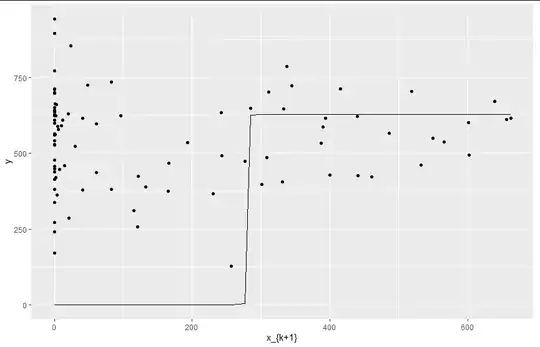For simplicity write $x=x_1$ and $y=x_2,$ so that
$$2\bar x = x+y,\quad s = \frac{1}{x} + \frac{1}{y} - \frac{4}{x+y}.\tag{*}$$
Their Jacobian $J(\bar x, s)$ can be computed by comparing the differential elements in the two coordinate systems
$$\mathrm{d} \bar x \wedge \mathrm{d} s = \frac{1}{2}(\mathrm{d} x + \mathrm{d} y) \wedge \left(-\frac{\mathrm{d} x}{x^2} - \frac{\mathrm{d} y}{y^2} + \frac{4(\mathrm{d} x + \mathrm{d} y)}{(x+y)^2}\right)=\frac{1}{2} \left(\frac{1}{x^2}-\frac{1}{y^2}\right)\mathrm{d} x\wedge \mathrm{d} y$$
(These differential forms and the wedge product are described at Construction of Dirichlet distribution with Gamma distribution.)
It remains only to divide both sides by $(1/x^2 - 1/y^2)/2$ and then re-express the left hand side entirely in terms of $\bar x$ and $s.$ Elementary algebra (see below for details) gives
$$\frac{1}{x^2}-\frac{1}{y^2} = \frac{s^{1/2}(2 + s \bar{x})^{3/2}}{\bar{x}^{3/2}},$$
whence
$$\mathrm{d} x\wedge \mathrm{d} y = \frac{1}{\frac{1}{2} \left(\frac{1}{x^2}-\frac{1}{y^2}\right)}\mathrm{d} \bar{x} \wedge \mathrm{d} s =\frac{2\bar{x}^{3/2}}{\sqrt{s}(2 + s \bar{x})^{3/2}}\,\mathrm{d} \bar x \wedge \mathrm{d} s = J(\bar x, s) \,\mathrm{d} \bar x \wedge \mathrm{d} s.$$
Thus, when converting an integral in terms of $(x,y)$ to one in terms of $(\bar x, s)$, the differential element on the left side must be replaced by the differential element on the right; the absolute value of the factor $J(\bar x, s)$ that is introduced is the Jacobian.
Here is one way to do the algebra. Multiplying $s$ by $2\bar x$ to clear the fraction in $(*)$ gives
$$2\bar{x} s = \frac{(y-x)^2}{xy}.$$
Adding $4$ to that produces
$$2\bar{x} s + 4 = \frac{(x+y)^2}{xy} = \frac{(2\bar x)^2}{xy},$$
which upon dividing both sides by $(2\bar x)^2$ establishes
$$\frac{1}{xy} = \frac{2\bar{x} s + 4}{(2\bar x)^2}.$$
For $y\gt x \gt 0$ we may combine the three preceding results to obtain
$$\left(\frac{1}{x^2} - \frac{1}{y^2}\right)^2 = \frac{(y-x)^2(x+y)^2}{(xy)^4} = (2\bar{x}s)(2\bar{x}s + 4)\left(\frac{2\bar{x} s + 4}{(2\bar x)^2}\right)^2.$$
Collecting identical terms in the fraction and taking square roots gives
$$\frac{1}{x^2} - \frac{1}{y^2} = \left(\frac{s(2\bar{x} s + 4)^3}{(2\bar x)^3}\right)^{1/2}$$
which easily simplifies to the expression in the question.
